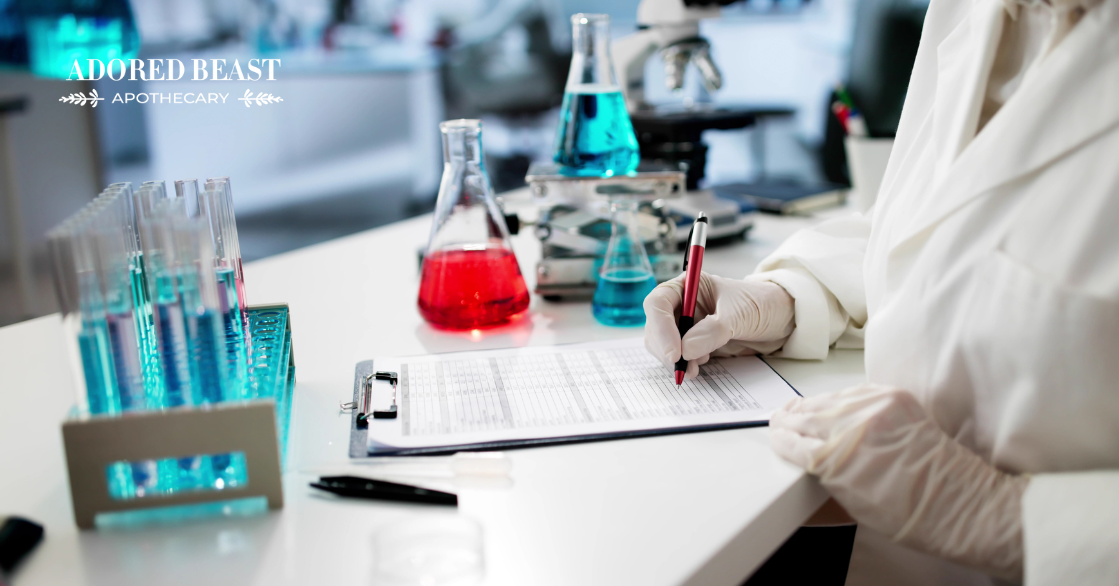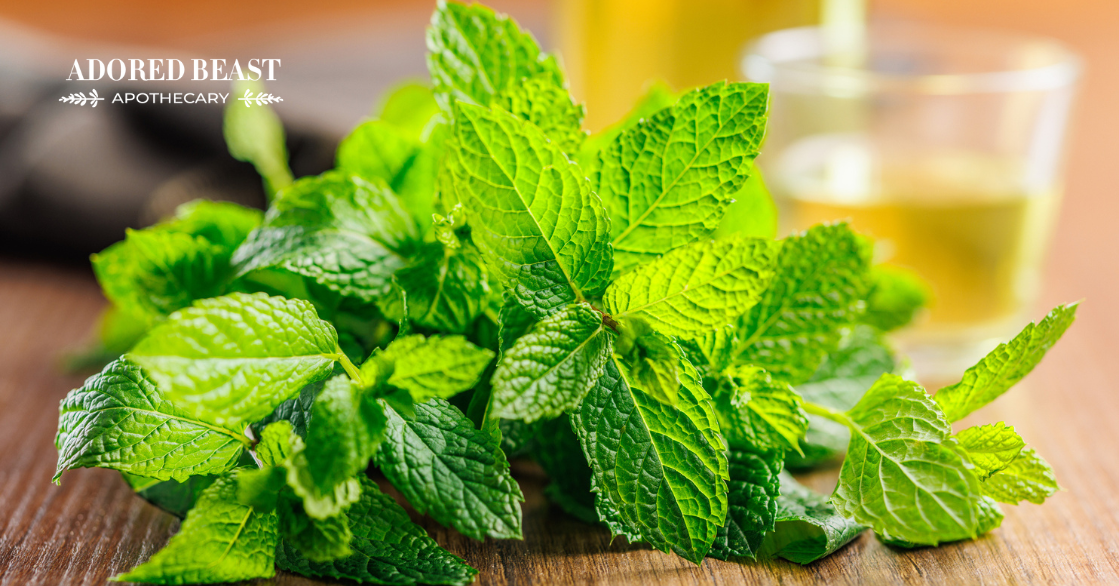As you may know, Julie Anne Lee DCH, the founder of Adored Beast Apothecary, has been a staunch advocate for the holistic treatment of our pets for many years. Her educational and professional journey began in 1990 when her four-year-old dog developed cancer. This diagnosis led Julie back to her roots and she chose to incorporate both conventional and traditional medicine methods into his treatment.
The approach was a success; he lived until he was almost 15 years old! This experience started Julie on a lifelong journey, beginning with her training as a homeopath, studying under many globally renowned homeopaths, followed by the opening of the first holistic veterinary clinic in Canada, and culminating in the development of Adored Beast.
At Julie’s veterinary hospitals, cancer was one of the most common diseases she dealt with. She found that the use of natural bioactive compounds for the treatment of cancer and other chronic diseases was incredibly successful and supported the overall health of the animals she treated.
This knowledge and experience are, now many years later, coming to fruition, with a canine cancer research project that could forever change the way we approach cancer in our animals.
The Dreaded C Word
Today, almost half of dogs over age 10 are diagnosed with cancer, and one in four develop cancer in their lifetime.1 Canine osteosarcoma is the most common bone cancer in dogs and is very painful and aggressive. It is especially prevalent in large and giant breeds. It often goes undetected until the dog begins to limp or show signs of lameness. The main treatment is amputation, but in most cases, the cancer has already spread to other areas of the body. Chemotherapy or radiation therapy may also be pursued in conjunction with amputation.
As you may know, or can imagine, these treatments are very harsh and can often cause other side effects that affect quality of life. However, without treatment, the average survival time for dogs is about two months. With surgery and chemotherapy, the median survival time is only nine months.2 The lack of treatment options and poor prognoses, combined with her experience in holistic medicine, spurred Julie to pursue research on the use of natural bioactive compounds for the prevention and treatment of cancers like canine osteosarcoma.
What are natural bioactive compounds? They’re components found in renewable sources that can have health benefits. They are a vital resource for drug discovery and can be used to treat a range of health issues. Some examples of natural bioactive compounds include things like flavonoids, fatty acids, and carotenoids.
A Partnership in Health
Several years ago, Julie was approached by Dr. Vasantha Rupasinghe, a leading researcher in natural health at Dalhousie University, to discuss her interest in exploring canine cancer research. Based on what she saw in her clinics, Julie hypothesized that combining bioactive compounds from nature could have synergistic effects that would amplify their cancer-fighting benefits. Calling on her years of experience and published scientific research, Julie theorized that combining Chaga mushroom and microalgae could have potent effects on both the prevention and treatment of cancer, with fewer side effects than chemotherapy or radiation.
The Chaga mushroom, Inonotus obliquus, which grows on birch trees, has been used in traditional medicine for hundreds of years to boost immunity and support overall health and well-being. It contains a variety of bioactive compounds including beta-glucans, antioxidants and triterpenoids. Some of these compounds have shown anti-cancer potential in research studies.3 Microalgae is known to contain a variety of vitamins, minerals and proteins but also contains other bioactive compounds like carotenoids and sterols. Multiple bioactives in microalgae have also shown anti-cancer properties.4 Dr. Rupasinghe believed in Julie’s vision, and together they embarked on a multi-year research project.
The Canine Cancer Research
The first part of our canine cancer research project was designed to see if different Chaga/microalgae extracts could damage or kill different cancer cell lines.
Different methods were used to extract the active compounds from the Chaga and microalgae. Five different Chaga extracts and three different microalgae extracts were produced. The extracts were then analyzed to see what bioactive compounds they contained. The researchers were specifically interested in phenolic acids, flavonoids, and triterpenoids because these compounds have research supporting their anti-cancer potential. The variety and amount of bioactive compounds changed depending on the extraction liquid and process used, and Chaga extracts had a much different bioactive profile than microalgae.
The next step was to test to see if the extracts had cytotoxic (cell-killing) properties against different types of cancer. Each extract was applied to five different cancer cell lines to see if the cells would live or die. Human breast cancer, liver cancer, and osteosarcoma cells were tested, along with canine osteosarcoma and histiocytosis. The results showed that some extracts were more effective at killing cancer cells than others, but in general, the viability of the cancer cells decreased as the concentration of extract increased. All extracts had a dose-dependent effect, so higher concentrations were more effective than lower concentrations.
It was important to confirm that the extracts would only kill cancer cells and not healthy cells. To test this, human breast cancer, human osteosarcoma and canine osteosarcoma cells were treated with different Chaga extracts. Healthy human breast, human osteoblasts and canine osteoblasts were also treated. The viability of the cancer and healthy cells were measured and it was found that extracts were able to prevent cancer cell growth while sparing the healthy cells. Amazing!
Better Together
Once it was confirmed that the extracts were not toxic to healthy cells, the researchers sought to determine if combinations of Chaga and microalgae extracts could have higher anti-cancer effects than the individual extracts. This was the core principle of Julie’s hypothesis: when natural bioactive compounds are combined, do they exhibit synergistic effects?
To test this, researchers combined the Chaga and microalgae extracts that showed the highest anti-cancer effects individually. Different ratios of the extracts were applied to cancer cells and it was found that 1:4 and 4:1 of Chaga extract to microalgae extracts showed very high synergy against cancer cells, thus confirming Julie’s original hypothesis.
Check it out: This research was published in the Oxidative Medicine and Cellular Longevity journal.5
Even More Good News
The next step was to determine if these extracts had any other beneficial health effects, specifically, if they had any effect on inflammation, which we know is linked to many different diseases and health conditions!
We’re about to get really science-y here, but it’s very cool stuff!
To test anti-inflammatory effects, mouse macrophages (cells) were treated with different concentrations of either the Chaga or microalgae extract for 24 hours, and then treated to induce inflammation. Levels of three different inflammatory markers (IL-6, TNF-α, and COX-2), as well as the anti-inflammatory cytokine IL-4, were analyzed to see if the extracts could increase levels of this important anti-inflammatory biomarker.
Both extracts were very effective at suppressing the production of IL-6 and TNF-α, and the effects were dose-dependent. This means that the more extract was used, the more effective it was at suppressing the production of the inflammatory markers. Both extracts were also effective at suppressing COX-2 production, but only at the highest concentrations tested. In addition, while the amount of IL-4 production increased with increasing dosage of extract, neither Chaga extract nor microalgae extract resulted in a statistically significant increase.
The results of this study showed that Chaga extract and microalgae extract can significantly reduce the amounts of inflammatory markers in cells that have been treated to induce inflammation. And a reduction of these markers could lead to an improvement in overall health and well-being.
Check it out: These results were published in the Medical Research Archives journal.6
What’s Next?
More canine cancer research of course!
While the research conducted on cancer treatment and prevention so far is very positive, there is still more work to be done. A pre-clinical trial is currently underway at Dalhousie University to determine if the work performed in cell models can be replicated in animal models. The work on this study is expected to be completed in early 2025. Assuming this research is successful, Julie will continue to work with Dr. Rupasinghe to conduct clinical trials in animals. The ultimate goal of this research is to develop a cancer treatment that can be administered by veterinarians, with fewer side effects than current cancer treatments. And, hopefully, something that can make its way into the hands of vets and pet parents alike, to help promote animal health and minimize the risk of chronic disease and health conditions.
You’ve probably heard us talk before about turning to nature for the answers, or about how everything in nature works together. This canine cancer research aims to take that understanding and wisdom and turn it into something all animals can benefit from. And in our books, that’s always a very good thing.
References:
- American Veterinary Medical Association. Cancer in Pets. Accessed November 19, 2024 from www.avma.org/resources/pet-owners/petcare/cancer-pets
- Cornell Richard P. Riney Canine Health Center. Osteosarcoma in Dogs. Accessed November 19, 2024 from www.vet.cornell.edu/departments-centers-and-institutes/riney-canine-health-center/canine-health-information/osteosarcoma-dogs
- Lu Y, Jia Y, Xue Z, et al. (2021), Recent Developments in Inonotus obliquus (Chaga mushroom) Polysaccharides: Isolation, Structural Characteristics, Biological Activities and Application. Polymers. 13(1441)
- El-Hack ME, Abdelnour S, Alagawany M, et al. (2019), Microalgae in modern cancer therapy: Current knowledge. Biomedicine and Pharmacotherapy. 111:42-50
- Wagle S, Lee JA, Rupasinghe HPV (2024), Synergistic cytotoxicity of Chaga mushroom and microalgae against mammalian cancer cells in vitro. Oxidative Medicine and Cellular Longevity. 7944378
- Wagle S, Thilakarathna W, Lee JA, Rupasinghe HPV (2024), Anti-inflammatory effect of extracts of Inonotus Obliquus and microalgae. Medical Research Archives. 12(2)












